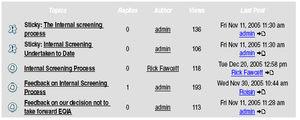The e-consultation
Contents
The E-Consultation Experience
- Readers could browse the online consultation document (in HTML format) to become familiar with the particular issues that concerned them. Here is example of the text:
| INTERNAL SCREENING PROCESS |
|---|
| As a new organisation, developing new policies, Waterways Ireland's approach has been to seek to mainstream consideration of equality in policy development. To do this we are implementing an Internal Screening Process to identify and where possible remove any adverse equality impacts from new policies whilst these are being developed.
Waterways Ireland's internal screening process has two steps:
|
- Readers could then respond to the issues by going to the Submissions page, an online forum, and either join or create a discussion. An example screen shot is also provided.
- To encourage discussion, the forums posted starting questions. Some questions are exampled below:
| Waterways Ireland is seeking your feedback on: The Internal Screening Process developed to ensure new policies are equality proofed as they are developed. |
| Waterways Ireland is seeking your feedback on: Our decision not to take forward EQIAs on these policies. |
| Waterways Ireland is seeking your feedback on: Are there policies in Table B which we have screened as not requiring an EQIA, which you believe should be subjected to EQIA? |
| Waterways Ireland is seeking your feedback on: Do you agree with our proposed timetable for carrying out EQIAs? |
- Other readers could respond to any comments made, within any forum.
Problems Identified
An analysis of the e-consultation system and user activity highlighted certain flaws, which acted as a barrier to effective e-consultation. They are as follows:
Not ready for respondents
The research team set up a site for the e-consultation on their own servers, at http://waterways.e-consultation.org, as the Waterways Ireland web site was not set up at that time to run discussion forums. Although the Waterways Ireland team publicised the URL http://waterways.econsultation.orgin their e-mails, inviting organisations to respond to the consultation, the Waterways Ireland team did not highlight the e-consultation on their own home page.
Neglected how users browse online
As noted, the consultation document was put on-line, not as one long linear PDF to download and print, but in HTML, broken up into a number of pages, with the hope that readers might browse to particular issues that concern them, and then respond on those issues. It was, however, written in the same language as the paper consultation document. Although this ensured that everyone was responding to the same text, it did not account for the differences by which people read linear paper documents and browse on-line web pages.
Lack of online discussion
Readers were invited to read the paper consultation document, then submit their views in an on-line forum. Twelve people went as far as to register on the discussion forum (6 internal, 6 from outside Waterways Ireland), but no-one external to Waterways Ireland went on to submit a comment to the discussion forum. In fact, of the six responses Waterways Ireland did receive to their consultation, all of these were paper submissions.
It seems that quite a few people viewed the discussion forum but hardly any respondent was willing to write and submit their views. The starting questions for each thread were hardly designed to generate emotional engagement.
